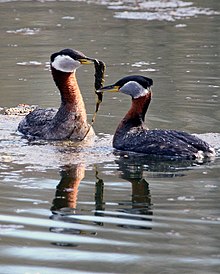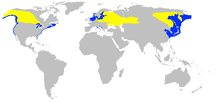Red-necked grebe
| Red-necked grebe | |
|---|---|
 |
|
| Gifts of aquatic plants are part of the courtship display | |
| Scientific classification | |
| Kingdom: | Animalia |
| Phylum: | Chordata |
| Class: | Aves |
| Order: | Podicipediformes |
| Family: | Podicipedidae |
| Genus: | Podiceps |
| Species: | P. grisegena |
| Binomial name | |
|
Podiceps grisegena (Boddaert, 1783) |
|
 |
|
| Range of P. grisegena Breeding range Wintering range | |
| Synonyms | |
|
Podiceps griseigena (Lapsus) |
|
Podiceps griseigena (Lapsus)
The red-necked grebe (Podiceps grisegena) is a migratory aquatic bird found in the temperate regions of the northern hemisphere. Its wintering habitat is largely restricted to calm waters just beyond the waves around ocean coasts, although some birds may winter on large lakes. Grebes prefer shallow bodies of fresh water such as lakes, marshes or fish-ponds as breeding sites.
The red-necked grebe is a nondescript dusky-grey bird in winter. During the breeding season, it acquires the distinctive red neck plumage, black cap and contrasting pale grey face from which its name was derived. It also has an elaborate courtship display and a variety of loud mating calls. Once paired, it builds a nest from water plants on top of floating vegetation in a shallow lake or bog.
Like all grebes, the Red-necked is a good swimmer, a particularly swift diver, and responds to danger by diving rather than flying. The feet are positioned far back on the body, near the tail, which makes the bird ungainly on land. It dives for fish or picks insects off vegetation; it also swallows its own feathers, possibly to protect the digestive system. The conservation status of its two subspecies—P. g. grisegena found in Europe and western Asia, and the larger P. g. holboelii (formerly Holbœll grebe), in North America and eastern Siberia—is evaluated as Least Concern, and the global population is stable or growing.
Grebes are small to medium-large water birds with lobed, rather than webbed, toes. There are several genera, of which the most widespread is Podiceps with nine species, one recently extinct. The red-necked grebe's closest relative is the fish-eating great crested grebe of Europe and western Asia. It is possible that the red-necked grebe originally evolved in North America and later spread to Europe, where a change of diet to include more insects helped to reduce competition with its larger cousin. Fossils of the species dating to the middle have been found in Italy.
...
Wikipedia

